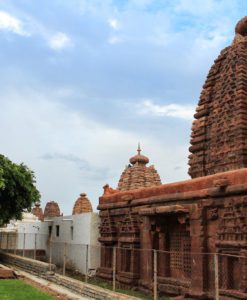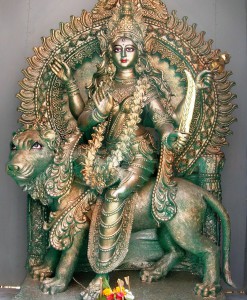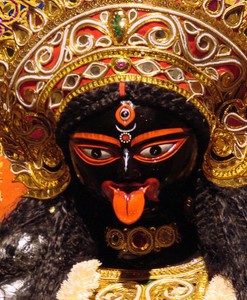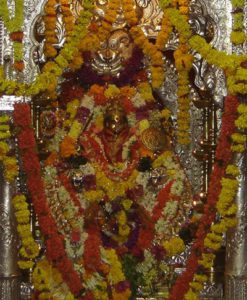No products in the cart.
Kalighat Kali Temple
Kalighat Kali Temple is dedicated to Maa Kali. It is one of the 4 main Shakti Peethas in India. The other three are Kamakshya, Tara Devi & Bimala. Kalighat was a Ghat (landing stage) sacred to Kali on the old course of the Hooghly River (Bhāgirathi) in the city of Calcutta. The name Calcutta is said to have been derived from the word Kalighat. The river over a period of time has moved away from the temple. The temple is now on the banks of a small canal called Adi Ganga which connects to the Hooghly.
Goddess Kali is regarded as the most compound goddess of the Hindu pantheon. Usually depicted in a horrendous form, Kali is the destroyer as well as the liberator. Goddess Kali, in her wrothful form, is worshipped by thousand of devotees, who come all the way from distant parts of India and the World. The temple attracts a major portion of visitors to Kolkata and other parts of West Bengal.Kalighat Temple is a significant religious place for the followers of Hinduism. As per the legends, the different body parts of Sati fell on the earth at the time of self-sacrifice. It is believed that the right toe of Sati fell here and subsequently; the temple was erected to commemorate the Goddess. Goddess Kalika is the presiding deity in the Kalighat Temple.
- Temple History
- Legend
- Architecture
- How To Reach The Temple
- Daily Poojas And Festivals
- Videos
- Additional Information
The Kalighat kali temple in its present form is about 200 years old, although it has been referred to in Mansar Bhasan composed in the 15th century, and in Kavi Kankan Chandi of the 17th century. Only two types of coins of Chandragupta II, who incorporated Vanga in the Gupta Empire, are known from Bengal. His Archer type coins, which became the most popular type of coinage with the Gupta rulers after Kumaragupta I, have been found in Kalighat. This is evidence of the antiquity of the place.
The original temple was a small hut. A small temple was constructed by King Manasingha in the early Sixteenth century. The present temple was erected under the patronage of the Sabarna Roy Chowdhury family of Banisha. It was completed in 1809. The Haldar family claims to be the original owners of the temple property. But this was disputed by the Chowdhrys of Banisha. In the nineteen sixties a committee was formed for the administrative management of the temple with representation from the Government and the Haldar family. The responsibility of conducting the worship rests with the Haldars and their heirs, generally known as sebadas.
Kalighat kali temple is regarded as one of the 51 Shakti Peethas of India, where the various parts of Sati’s body are said to have fallen, in the course of Shiva’s Rudra Tandava. Kalighat represents the site where the head of Sati fell. But some people believe that the right toe of Sati fell here.
The image of Kali in this temple is unique. It does not follow the pattern of other Kali images in Bengal. The present idol of touchstone was created by two saints – Brahmananda Giri and Atmaram Giri. Three huge eyes, long protruding tongue made of gold and four hands in which two hands will be holding a sword and a severed head. The Sword signifies Divine Knowledge and the Human Head signifies human Ego which much be slain by Divine Knowledge in order to attain Moksha. The other two hands are in the abhaya and varada mudras or blessings.
The Kalighat Kali Mandir is a classic example of the Bengali architectural style which is a structural emulation of the mud and thatch-roofed huts of the villages. Kalighat’s main temple is a four-sided building with a truncated dome. A smaller identically-shaped projection caps this domed structure. Each sloping side of the roof is referred to as a chala Therefore the Kalighat Mandir is designated as chala temple. The two roofs will bear a total of eight separate faces. This stacked, hut-like design is common for Bengali temples and we find the same exact style of architecture used at another shakti peeth.
Both roofs are painted with shiny, metallic silver and are decorated with bright bands of red, yellow, green, and blue where they join the building at the cornice. The uppermost roof is topped by three spires with the tallest central spire bearing a triangular pennant flag. Each of the mandir’s outer walls is decorated with a diamond chessboard pattern of alternating green and white tiles. A recent addition to the temple complex is the implementation of an elaborate lighting system which creates a novel mood and causes the mandir to glow with funky colors throughout the night.

Kali Idol at Kalighat Mali Mandir
The main shrine comprises the idol of Goddess Kali. The idol of Goddess Kali is made of black stone and decorated with gold and silver. The one of Lord Shiva is in silver. Three beautiful yet fiery eyes, long protruding tongue made of gold and four hands, which all are made of gold too. Two of these hands holding a scimitar and a severed head of the asura king ‘Shumbha’. The scimitar signifies divine Knowledge and the asura (or, human) head signifies human ego. The other two hands are the abhaya and varada mudras or blessings, which means her initiated devotees (or anyone worshiping her with a true heart) will be saved as she will guide them here and hereafter. The goddess is offered a ceremonial bath every year on the snan-yatra day, the rituals being performed by the priests who cover their eyes with cloth during the ceremony. Kali represents the destructive side of Siva’s consort and demands daily sacrifices; therefore in the morning goats have their throats slit here to satisfy the goddess’s bloodlust. The Kali idol, primitively only had her face. Further tongue and hands made of gold and silver were added to the image. Another Kalika murti which is housed within is a representation of the goddess considered so powerful that it is never displayed to the public, nor ever seen by the priests. This hidden image of the goddess was not made with human hands, but was created by nature, and is therefore described as the self-generated, or svayambhu image of Kalika. Identified as one of the toes from Sati’s right foot, the adi rup (original form) is said to have fallen at this shakti pith, and is concealed within the pedestal upon which the Kalika murti stands.
Right adjacent to the temple lies the Natmondir- it’s a platform through which the deity could be seen directly. Right next to the natmondir lies two sacrificial altars which also have a murti of Radha-Krishna. A sacred tank called Kundupukar lies in the south-east corner of the temple premises. The water of this pond is consider to be as holy as river Ganga and and has the power to bestow the boon of a child. There are two queues going for darshan, i.e. Garbha-Graha (Nijo-Mandir) and other for having darshan from Verandah. (Jor- Bangla).
Kalighat Kali Temple By Road
The temple is located on the old course of Hooghly River. Buses are available from all parts of Calcutta. All buses going to south Calcutta have to pass through Shyam Prasad Mukherjee road. The temple is off this road. You get down in Kalighat (Kalighat Tram Depot) bus stop and walk down the Kali Temple road to the temple. Kalighat is connected by Metro railway. Kolkata is connected with most of the Indian cities by road. The National Highway number 2 and 6 connect the city with other cities and states in India. Kolkata has a broad network of government and private buses. The Calcutta State Transport Corporation (CSTC), Calcutta Tramways Company (CTC) and West Bengal Surface Transport Corporation (WBSTC) run regulars bus service in the city. The Esplanade Terminus in the heart of the city is the main bus terminus.
Kalighat Kali Temple By Rail
The Temple is well connected through nearest Howrah railway station (9.7 kms) to major cities railway stations like Delhi, Agra, Mumbai, Chennai, Ajmer, Pali, Jaipur, Ahmedabad. The nearest metro stations are Jatin Das Park and Kalighat. Please take the Northern exit in Jatin Das Park and the Southern exit in Kalighat.
Kalighat Kali Temple By Air
The Temple can be reached through nearest Netaji Subhash Chandra Bose International Airport (23.2 Km) which is well connected with regular domestic flights to Delhi, Mumbai, Bangalore, Hyderabad, Chennai and other metropolitan cities.
Kalighat Kali Temple
The temple is open from 5.00 A.M. to 2.00 P.M and 5.00 P.M to 10.30 P.M. It is closed from 2.00 P.M to 5.00 P.M. for Bhog. There are Aartis in the morning and evening. Tuesdays and Saturdays are special days for worship. Ashtami days are also special. If you want to avoid the crowds the best day to visit is Wednesday or Thursday.
Poojas performed in the temple:
The schedule of rituals that take place at the Kalighat Mandir follow a course which reflects rhythm of human life. Kalika is viewed as a living goddess whose daily needs are attended to with the utmost reverence by her priesthood. Beginning at 4:00 am, she is gently awoken, after which her image is cleaned and decorated with garlands of red hibiscus flowers before the temple doors are opened to the public. At 6:00 am the elaborate ceremony of Kalika’s morning aarti begins. The doors to the garbhagriha remain open until 2:00 pm, when they are closed so that the pujaris can offer Kalika her food in private. For a period of time, the temple doors remain locked while the goddess eats and takes a nap. The prasad of this food offering is later distributed to temple employees, pilgrims, and local beggars. At 4:00 pm, the doors are again opened for devotees to commune with Kalika and havedarshan with her murti. Some evening rituals, including a night time aarti, are performed before thegarbhagriha’s doors officially close to the public around 11:00 pm. Kalika is then lovingly dressed and prepared for bed.
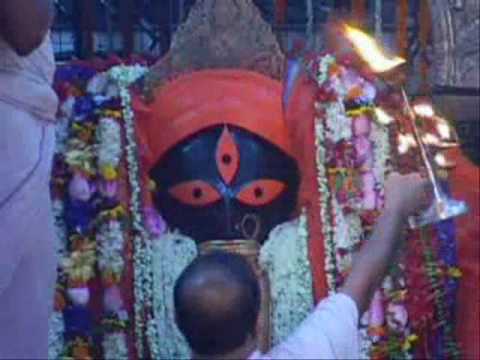
Festivals at Kalighat Kali Mandir
The divine pilgrimage destination observes a flock of devotees during the various festivals at the temple which include Durga pooja, Kali Pooja, Poila Boishakh. Dondi festival is a festival performed in the temple during Sheetla Pooja wherein the ladies pray be laying down on the ground and covering the distance to the temple by moving in the same position. They go on marking the distance with a chalk. (Picture depicting Dondi Festival)

Animal sacrifice or commonly known as Boli, is a vital ritual followed here. A concrete fence serves to obscure the sacrificial area from the view of casual onlookers and define the space within, where goats are beheaded as an offering to Kalika. Almost 499 goats are offered to the Goddess every year which serves as a sacrifice to her blood lust.
Other places which are worth visiting in Howrah: The Great Banyan Tree, Benapur, Ram Mandir, Belur Math, and MadanMohan-jiu Temple.
Things to keep in mind
- Stay away from the priests (pandas).
- This is a good place to visit the local traditional art of painting style called KALIGHAT PATA PAINTING.
- Tuesdays and Saturdays are special days for worship including Ashtami.
- It is best suited for spiritual people, photo fanatic people, people who are looking for art and traditional of Kolkata.




